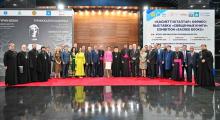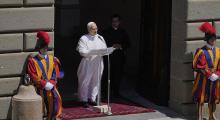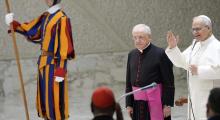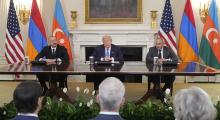Issued by the Catholic Center for Studies and Media - Jordan. Editor-in-chief Fr. Rif'at Bader - موقع أبونا abouna.org
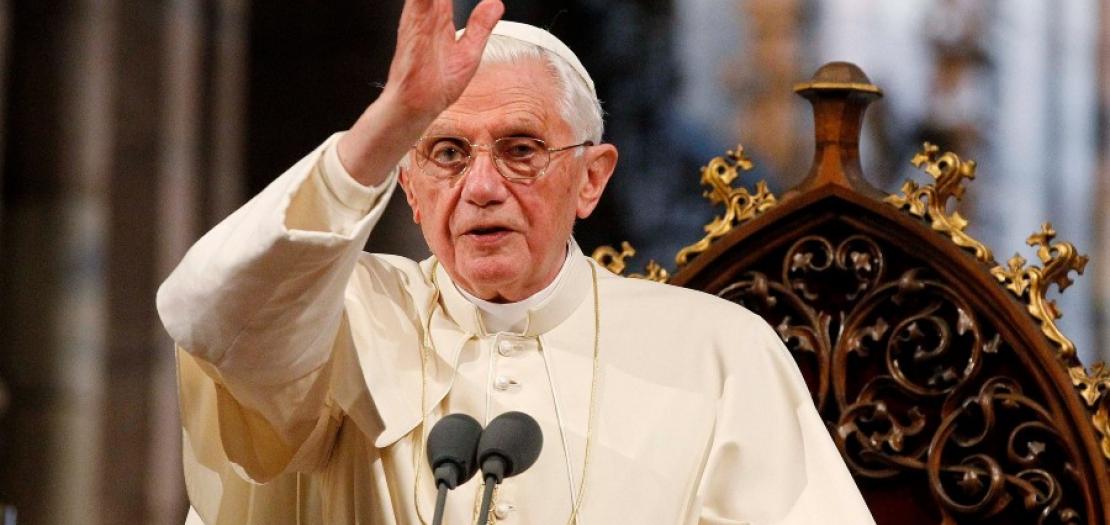
Fitting words escape me to praise a man who has impacted the Church so profoundly. I found myself turning to God’s own words to capture the impact of Joseph Ratzinger’s teaching, leadership, and liturgical sense: “There was a man sent from God. . . . He came for testimony, to bear witness to the light, that all might believe through him” (John 1:6-7). Although intended for John the Baptist, these words do justice to Ratzinger as a great witness to the light for our times.
Reflecting on Ratzinger’s enormous legacy, I am drawn to three additional passages of Scripture: the scribe, the steward, and the true worshipper. These passages reflect the primary elements of Ratzinger’s legacy as theologian, shepherd, and prophet of liturgical renewal.
The treasure both new and old reflects Ratzinger’s uncanny ability to return to the sources of Scripture and the Church Fathers and to draw new insights from them. He looked into the tradition with fresh eyes, while understanding the problems and needs of the moment. At a time when it was fashionable to discard the Church’s history, he helped to recover it and make it living again, ordering his thought toward the renewal of the Church.
In my opinion, Ratzinger will be remembered as the best theologian of the twentieth century, having the longest and most impactful legacy of any Catholic theologian since Newman. He represents the best of what was intended by the ressourcement movement. He understood that something new was needed, but that this new style should not create a break with the past, but offer a fresh presentation of what is always new and never old.
The world and even the Church had grown weary eyed in looking at the Gospel. Every time I read even a short passage of one of his books or an address he gave, I am always struck by the profound depth he offered on any topic he approached. Every sentence exudes unexpected wisdom.
It is impossible to capture his theological contribution in a short tribute, but his writings on biblical interpretation provide a perfect example. Scholarship on the Bible had become almost completely secular and skeptical. Faithful Christians, therefore, had been tempted to write off critical scholarship. Rather, Ratzinger proposed, especially in his Erasmus Lecture, a new synthesis, founded on the primacy of reading the Bible as a unified text with faith, while drawing upon any helpful historical and literary insights of the new methodology.
Ultimately, his view of scriptural interpretation points us to a central theme of his theology as a whole, the harmony of faith and reason. In his Regensburg address, he explained how the Bible itself communicates this vision to us:
The Bible addresses us as rational beings and invites faith as a response of the mind informed by the truth of the creation.
His Introduction to Christianity encapsulates his broader work, of reintroducing the basics of Christianity, showing us that we need to cast off our complacency to listen to the message of the Gospel anew. In the same way, he wanted us to see Jesus in a renewed way in his Jesus of Nazareth volumes, as “a historically plausible and convincing figure” (vol. 1, xxii). Although he never completed his intended magnum opus of a complete work of systematic theology, we nonetheless have an extensive body of works on a broad range of topics that will keep us busy for some time.
As Pope, his poignant analysis of the Church and world came through best in the monumental speeches he delivered throughout Europe:
Ratzinger, like St. Gregory the Great, was not permitted to embrace a life of quiet contemplation and study, but was thrust into the center of the pastoral life of the Church. His work in this service was not a distraction or in opposition to his theological vocation, but enabled it to shape the life of the Church in an organic way.
He knew what was at stake in the Church’s mission, beginning his seminary formation within the crucible of the Second World War. As a young priest he continued his studies, taught catechesis, had parish duties, and became a university professor. He ruffled feathers early on with his essay, “The New Pagans and the Church,” even upsetting his bishop, Cardinal Joseph Wendel. This essay began a long struggle against secularism not only in society, but also in the Church.
The Second Vatican Council, a truly pivotal moment in his life, placed Ratzinger, at the young age of thirty-five, in the midst of the Church’s efforts to find a new way to engage the modern world. As a peritus, or theological expert, for one of the most influential bishops, Cardinal Josef Frings, he had the opportunity to help shape the Council’s direction, particularly by advocating for a rejection of pre-prepared documents and by helping to draft new texts. After the Council, he achieved success as a professor, taking a position at Tübingen.
The Lord called him to be a shepherd, however, and so he abandoned the university, somewhat reluctantly, and accepted his appointment as Archbishop of Munich in 1977. He was named a Cardinal by Paul VI shortly after and only a few years later, John Paul II convinced him, once again reluctantly, to come to Rome to serve as his Prefect for the Congregation for the Doctrine of the Faith. His service in this position flowed naturally from his commitment to the truth at the service of the Church’s ministry. He lived up to his episcopal motto, Fellow Workers in the Truth, working collaboratively with bishops around the world, especially in the creation of the Catechism of the Catholic Church.
Elected as chief shepherd of the flock, in 2005, he proved himself to be a gentle and yet courageous Pope. He proved cautious, nonetheless, and unwilling to force his views of Church reform (to a fault), but would act for the salvation of souls regardless. We see this in his unwillingness to push liturgical reform, but his willingness to go over the head of the English Bishops to form ordinariates for Anglicans. Creating the ordinariates was an historic move, showing his boldness to form new structures and contravene political correctness when it mattered most. Another example of this courage can be found in Summorum Pontificum, removing restrictions on celebrating the Tridentine Mass.
No one thought that administration was Ratzinger’s strong point as Pope. Nonetheless, he had his priorities. He emphasized the appointment of solid bishops and ensured that his appointees were doctrinally sound and willing to engage the culture and evangelize. He also put reforms in place to address sexual abuse (building on his work in the CDF) and to regularize financial practices (which faced heavy opposition).
Throughout his ministry as priest, bishop, curia official, and Supreme Pontiff, he gave us our needed food in due season. In a time of doctrinal and pastoral chaos, the Lord raised up Ratzinger to feed us with the truth of His Gospel in a way that didn’t shrink back from the challenges presented by the secular culture. In fact, he held out faith as the only antidote to the anti-human spirit of our time. He insisted that true freedom comes only from obedience to God.
Ratzinger understood the one thing necessary, of which Jesus spoke to Martha (Luke 10:42). Sitting at the Lord’s feet, entering into communion with Him—these are the most important realities in the life of the Church. Ratzinger grasped this “one thing,” in the midst of a spiritual crisis in which material concerns were put before faith and worship. One example came from liberation theology, making the Kingdom into something earthly. It was a time of experience based catechesis, more focused on the signs of the time than the Gospel. In response, Ratzinger served as a prophet calling the Church to worship in spirt and truth.
In a preface for the Russian edition of volume 11 (the first released) of his opera omnia, he described the centrality of the liturgy:
Ratzinger has called us to put Christ first and to center our liturgy on Him and not ourselves. His theological vision as a whole tires to reorient us to a theocentric not anthropocentric vision and practice.
Worship has become mundane, flat, and self-focused—an ineffective form of entertainment. In one of his greatest works, The Spirit of the Liturgy, Ratzinger pulls no punches when examining the worship of the golden calf and noting that it is a “circle closed in on itself,” “self-seeking,” “banal self-gratification,” and “self-initiated” (23). Though using an Old Testament image, there is no doubt to what he is referring. We need worship, more than anything else. Not self-affirmation, not a sociological gathering, not a time of instruction, but real, genuine worship.
Ratzinger asks us, in a must-read address, to allow the beauty of Christ to permeate us, “being struck by the arrow of Beauty that wounds.” Simply talking about the truth of the faith is not enough. We need to experience the beauty of what we believe, which should shine forth in our worship. The liturgy expresses the joy of the Heavenly Jerusalem, breaking forth into time: “The feasts are a participation of God’s action in time, and the images themselves, as remembrance in visible form, are involved in the liturgical re-presentation” (Spirit of the Liturgy, 117). The form of the liturgy matters; our actions within it matter; the music matters; the images matter—because they all mediate a heavenly reality and therefore must adequately represent what they signify.
Those awaiting a reform of the reform were disappointed by the lack of decisive action by Ratzinger’s Papacy. Rather than initiating more tampering to the liturgy, he sought to restore its overarching, organic continuity through Summorum Pontificum. Standing side by side, he wanted the ordinary and extraordinary forms of the Roman rite to enrich each other, putting liturgical reform further off on the horizon, but taking a more natural course. As we allow this long process to bear fruit, we must fight to preserve and spread Ratzinger’s prophetic liturgical legacy.
Ratzinger provides us with a model of faithful service to the Lord and His Church. He never thought himself worthy of his ministry, but saw himself as a “a simple and humble labourer in the vineyard of the Lord.” He wanted to retire even before his papacy began, but he served to the extent of his strength. Like a good steward, entrusted with the truth and the Church’s worship, he will enter his reward.
Knowing its true quality, we can have confidence that his legacy will not be dismantled. Despite any actions to limit it or roll it back, it will continue to shine and illumine the church when the names of his critics will be long forgotten. Ratzinger did not work to create a legacy for himself, but to point us to the Lord. In this service, he does follow in the footsteps of John the Baptist, as a man sent from God to give testimony, bear witness, and inspire faith. Time will prove the enduring worth of his work as theologian, pastor, and liturgical prophet.
Those who have been enriched by Ratzinger’s teaching and example must work hard to appropriate and preserve his legacy. In my mind, we have only begun to communicate the rich treasures this steward has brought to the Lord’s house. As we remember this great man sent to us by God, we should consider how we can become a fellow worker in the truth with him.


